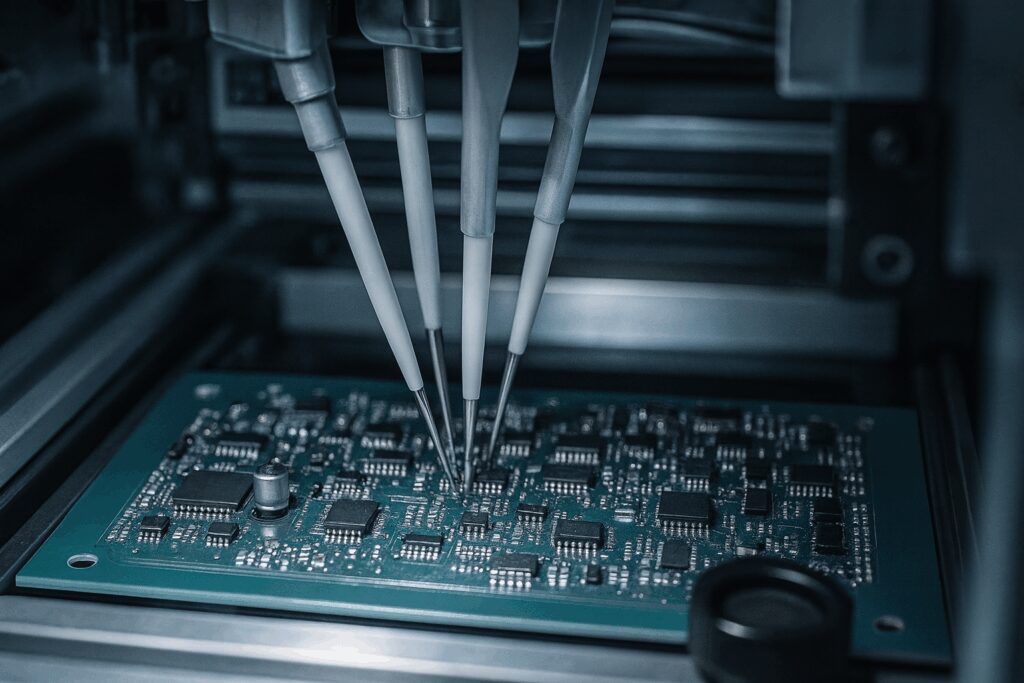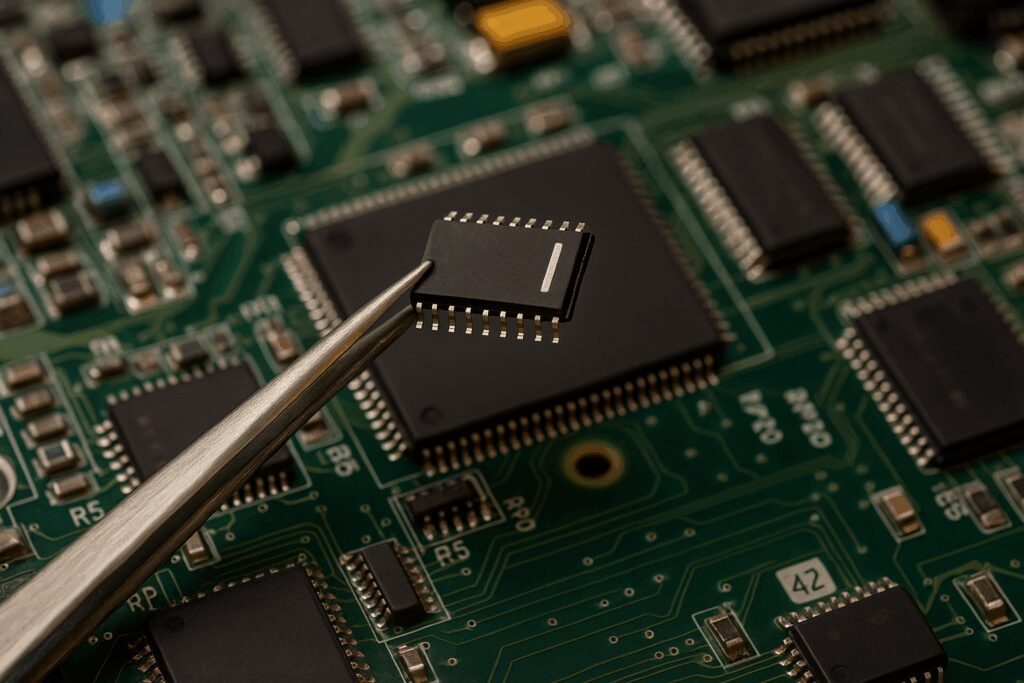What Makes Reliability Crucial in Aerospace and Defense Applications?
Reliability in aerospace and defense PCB assembly is non-negotiable. Aerospace electronics power aircraft systems, flight control systems, ground control stations, and communication systems that operate under the most challenging environments. Any failure in a critical component can jeopardize missions or, even worse, lives. Printed circuit boards (PCBs) serve as the backbone of electronic systems in aviation and space exploration; ensuring reliability in aerospace and defense PCB assembly safeguards high performance, signal integrity, and long-term operation in extreme conditions.
By adhering to stringent quality standards and rigorous testing, manufacturers deliver high reliability even under rapid temperature fluctuations, extreme temperatures, and mechanical stresses. Implementing an ISO-compliant quality management system further guarantees consistency across manufacturing processes, from component placement to automated optical inspection.
How Are Extreme Environments Addressed in Aerospace PCB Assembly?

Automated machine testing a circuit board with precision probes in a high-tech manufacturing setup.
Aerospace and defense industries contend with harsh environments that subject PCBs to radiation exposure, electromagnetic interference, and rapid thermal cycling. To withstand extreme conditions, aerospace PCBA utilizes:
- Radiation-hardened components: Essential for space exploration and high-altitude flight, where cosmic rays may disrupt electronic systems.
- Conformal coating: Protects circuits from moisture, dust, and outgassing in vacuum environments.
- Advanced thermal management solutions: Including thermal vias, high-temperature laminates, and metal core PCBs to dissipate heat efficiently.
These measures ensure that aircraft systems and avionics systems retain superior thermal stability, maintaining solder joint quality and component placement integrity under severe operational stress.
What Role Do Manufacturing Processes Play in Ensuring Reliability?
Reliable PCB assembly begins with robust manufacturing processes. Key steps include:
- Surface mount technology (SMT) for high-density component placement and repeatability.
- Wave soldering or selective soldering for through-hole components.
- Automated optical inspection (AOI) to detect assembly defects such as misaligned chips or solder bridging.
- X-ray inspection for hidden joints beneath BGAs (ball grid arrays).
A well-defined process flow minimizes defects and supports high repeatability. A certified quality management system enforces standardized procedures, traceability, and documentation, achieving consistent reliability across production batches.
How Are Quality Control and Rigorous Testing Implemented?
Quality control in aerospace PCB assembly encompasses multiple layers of inspection and testing:
- Incoming inspection of electronic components: Verifies authenticity and compliance to aerospace industry standards.
- In-process AOI: Ensures each solder joint meets solder joint quality requirements during the assembly process.
- Environmental stress screening (ESS): Subjects assembled boards to temperature extremes and vibration to uncover latent defects.
- Functional testing: Confirms that critical systems—such as flight control and communication modules—operate within specified parameters.
By combining automated optical inspection, X-ray inspection, and ESS, manufacturers validate that printed circuit board assemblies function reliably in real-world aerospace systems.
What Advanced Materials and Technologies Enhance PCB Reliability?

Tweezers holding a microchip above a green circuit board during electronic component assembly.
To achieve high performance in aerospace applications, PCB materials and core technologies are optimized for:
- High thermal conductivity: Materials like metal core PCBs and high-temperature laminates help dissipate heat from critical components.
- Rigid-flex PCBs: Provide mechanical flexibility with controlled impedance, essential for compact avionics modules.
- Advanced substrates: Ceramic-reinforced laminates resist thermal degradation under extreme temperatures.
These advanced materials support robust circuit board design, enabling aerospace pcbs to withstand rapid temperature fluctuations and mechanical stresses common in aircraft and ground control systems.
How Is Thermal Management Optimized in Aerospace PCBs?
Effective thermal management prevents hotspots that degrade electronic systems. Techniques include:
- Thermal vias: Vertical heat paths connect heat-generating components to heat sinks on internal layers.
- Heat sinks and spreaders: Mounted to critical ICs to increase surface area for heat dissipation.
- Advanced thermal interface materials: Improve contact between components and heat-dissipating structures.
Combining these thermal management strategies with high thermal conductivity substrates ensures superior thermal stability in aerospace applications, even under the most extreme operational conditions.
How Does PCB Design Integrate Reliability Factors?
Design for reliability begins in the schematic and layout phases:
- Signal integrity analysis: Ensures controlled impedance on high-speed communication lines.
- Component placement optimization: Minimizes thermal coupling between hot components.
- Redundant routing: Provides backup signal paths for critical flight control signals.
- Conformal coating allowances: Account for coating thickness in pad clearances and solder fillets.
By integrating these design practices, engineers create circuit boards that not only meet performance specifications but also satisfy the stringent reliability requirements of aerospace and defense applications.
What Industry Standards Govern Aerospace and Defense PCB Assembly?
Compliance with industry standards ensures uniform quality across manufacturers:
- IPC-6012: Qualification and performance specification for rigid PCBs.
- IPC-610: Acceptability criteria for electronic assemblies, including stringent solder joint quality standards.
- MIL-STD-810: Environmental test methods for military equipment, applied to PCBs for extreme condition resilience.
- AS9100: Quality management standard specifically for aerospace industry suppliers.
Adherence to these standards underpins the manufacturing processes, quality control, and testing protocols that guarantee high reliability in aerospace electronics.
How Can Supply Chain Risk Management Support Reliability?
Ensuring a secure, traceable supply chain is foundational to reliability. Key practices include:
- Vendor qualification: Only sourcing electronic components from trusted, certified suppliers.
- Batch traceability: Maintaining records of lot numbers and manufacturing dates for all critical components.
- Counterfeit detection: Utilizing X-ray inspection and component authentication to prevent the use of illicit parts.
- Dynamic risk assessments: Monitoring changes in tariffs, material shortages, and geopolitical factors that may impact availability.
A proactive approach to supply chain risk management safeguards the consistent availability of high-quality components, reinforcing reliability in aerospace and defense PCB assembly.
Conclusion: How Do All These Elements Combine to Ensure Reliability?
Ensuring reliability in aerospace and defense PCB assembly requires an integrated strategy that spans design, materials, manufacturing processes, quality control, testing, and supply chain management. By embracing rigorous testing, advanced thermal management, stringent quality standards, and proactive risk mitigation, manufacturers deliver aerospace pcbs that withstand extreme environments and fulfill critical system requirements.
Through a commitment to high reliability and continuous improvement, the aerospace and defense industries can maintain safe, efficient, and dependable electronic systems for aviation and space exploration.
Ready to Optimize Your PCB Assembly for Aerospace Reliability?
- Contract Manufacturing
- Design & Development
- Program Management
- Customize Your Product
- Supply Chain Risk Management
Works Cited
“AS9100 Quality Management Systems — Requirements for Aviation, Space and Defense Organizations.” International Aerospace Quality Group, www.iaqg.org.
“Environmental Stress Screening.” IPC, 2023, www.ipc.org/ess.
“IPC-6012: Qualification and Performance Specification for Rigid Printed Boards.” IPC, 2024.
“IPC-610: Acceptability of Electronic Assemblies.” IPC, 2024.
“MIL-STD-810: Test Method Standard for Environmental Engineering Considerations and Laboratory Tests.” Department of Defense, www.dod.gov.
“Radiation Hardened Microelectronics.” NASA Science & Technology, www.nasa.gov/rhman.
“Thermal Management Solutions for Electronics.” IEEE Transactions on Components, Packaging and Manufacturing Technology, vol. 11, no. 2, 2024, pp. 345–356.
Frequently Asked Questions (FAQ)
1. Why is ensuring reliability in aerospace and defense PCB assembly crucial?
Reliability is essential because aerospace and defense applications involve critical systems that operate in extreme conditions. Even a small failure in electronic components or circuit boards can lead to catastrophic outcomes, endangering missions and lives.
2. What role does thermal management play in aerospace PCB assembly?
Thermal management helps maintain component stability and prevents overheating by dispersing heat effectively. Techniques like heat sinks, thermal vias, and high thermal conductivity laminates ensure that aerospace electronics function reliably even in rapid temperature fluctuations.
3. How are PCBs tested to meet stringent quality standards in aerospace applications?
Rigorous testing methods—including automated optical inspection, X-ray inspection, environmental stress screening, and thorough assessments of solder joint quality—are used. These tests ensure that PCBs can withstand radiation exposure, mechanical stresses, and electromagnetic interference.
4. What are rigid-flex PCBs, and why are they preferred in aerospace systems?
Rigid-flex PCBs combine rigid and flexible circuit boards into a single design, offering enhanced durability and space-saving benefits. They provide superior reliability, especially in avionics systems and flight control applications that require resilience in challenging environments.
5. How can Vergent Products support reliability in aerospace and defense PCB assembly?
Vergent Products specializes in aerospace PCB assembly by using advanced technologies, rigorous quality control, and comprehensive manufacturing processes. Their services—from contract manufacturing and design development to supply chain risk management—ensure high reliability and optimal performance in aerospace and defense industries.

